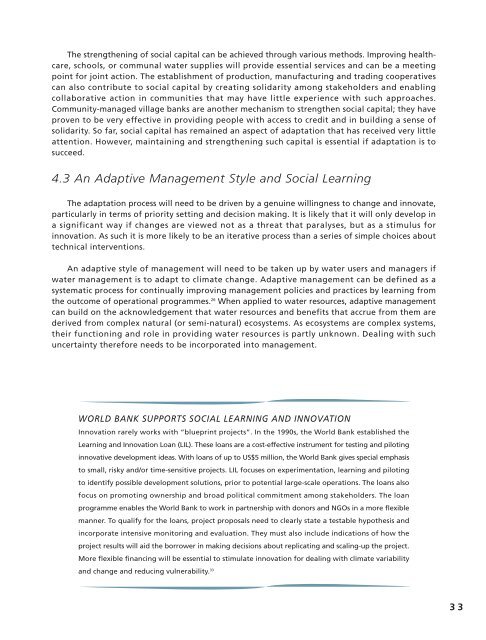Adaptation of water resources management to climate change
Adaptation of water resources management to climate change
Adaptation of water resources management to climate change
Create successful ePaper yourself
Turn your PDF publications into a flip-book with our unique Google optimized e-Paper software.
The strengthening <strong>of</strong> social capital can be achieved through various methods. Improving healthcare,schools, or communal <strong>water</strong> supplies will provide essential services and can be a meetingpoint for joint action. The establishment <strong>of</strong> production, manufacturing and trading cooperativescan also contribute <strong>to</strong> social capital by creating solidarity among stakeholders and enablingcollaborative action in communities that may have little experience with such approaches.Community-managed village banks are another mechanism <strong>to</strong> strengthen social capital; they haveproven <strong>to</strong> be very effective in providing people with access <strong>to</strong> credit and in building a sense <strong>of</strong>solidarity. So far, social capital has remained an aspect <strong>of</strong> adaptation that has received very littleattention. However, maintaining and strengthening such capital is essential if adaptation is <strong>to</strong>succeed.4.3 An Adaptive Management Style and Social LearningThe adaptation process will need <strong>to</strong> be driven by a genuine willingness <strong>to</strong> <strong>change</strong> and innovate,particularly in terms <strong>of</strong> priority setting and decision making. It is likely that it will only develop ina significant way if <strong>change</strong>s are viewed not as a threat that paralyses, but as a stimulus forinnovation. As such it is more likely <strong>to</strong> be an iterative process than a series <strong>of</strong> simple choices abouttechnical interventions.An adaptive style <strong>of</strong> <strong>management</strong> will need <strong>to</strong> be taken up by <strong>water</strong> users and managers if<strong>water</strong> <strong>management</strong> is <strong>to</strong> adapt <strong>to</strong> <strong>climate</strong> <strong>change</strong>. Adaptive <strong>management</strong> can be defined as asystematic process for continually improving <strong>management</strong> policies and practices by learning fromthe outcome <strong>of</strong> operational programmes. 26 When applied <strong>to</strong> <strong>water</strong> <strong>resources</strong>, adaptive <strong>management</strong>can build on the acknowledgement that <strong>water</strong> <strong>resources</strong> and benefits that accrue from them arederived from complex natural (or semi-natural) ecosystems. As ecosystems are complex systems,their functioning and role in providing <strong>water</strong> <strong>resources</strong> is partly unknown. Dealing with suchuncertainty therefore needs <strong>to</strong> be incorporated in<strong>to</strong> <strong>management</strong>.WORLD BANK SUPPORTS SOCIAL LEARNING AND INNOVATIONInnovation rarely works with “blueprint projects”. In the 1990s, the World Bank established theLearning and Innovation Loan (LIL). These loans are a cost-effective instrument for testing and pilotinginnovative development ideas. With loans <strong>of</strong> up <strong>to</strong> US$5 million, the World Bank gives special emphasis<strong>to</strong> small, risky and/or time-sensitive projects. LIL focuses on experimentation, learning and piloting<strong>to</strong> identify possible development solutions, prior <strong>to</strong> potential large-scale operations. The loans als<strong>of</strong>ocus on promoting ownership and broad political commitment among stakeholders. The loanprogramme enables the World Bank <strong>to</strong> work in partnership with donors and NGOs in a more flexiblemanner. To qualify for the loans, project proposals need <strong>to</strong> clearly state a testable hypothesis andincorporate intensive moni<strong>to</strong>ring and evaluation. They must also include indications <strong>of</strong> how theproject results will aid the borrower in making decisions about replicating and scaling-up the project.More flexible financing will be essential <strong>to</strong> stimulate innovation for dealing with <strong>climate</strong> variabilityand <strong>change</strong> and reducing vulnerability. 3333











![View full document [PDF 988.55 KB] - PreventionWeb](https://img.yumpu.com/47733942/1/184x260/view-full-document-pdf-98855-kb-preventionweb.jpg?quality=85)
![View full document (in French) [PDF 4.96 MB] - PreventionWeb](https://img.yumpu.com/47223870/1/184x260/view-full-document-in-french-pdf-496-mb-preventionweb.jpg?quality=85)


![View full document [PDF 25.02 MB] - PreventionWeb](https://img.yumpu.com/44204570/1/190x234/view-full-document-pdf-2502-mb-preventionweb.jpg?quality=85)
